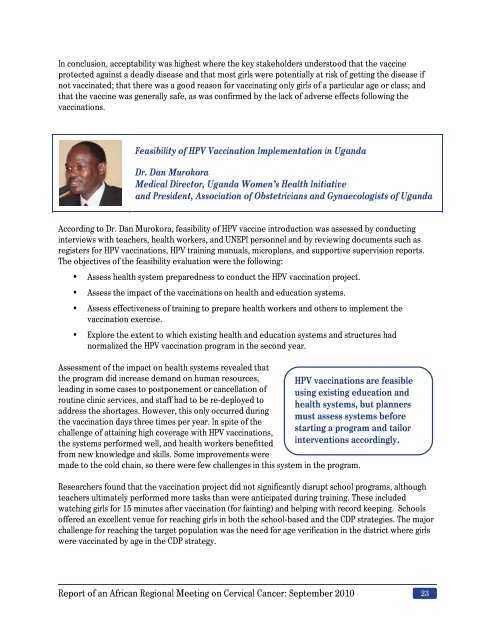Download file, English (1 MB PDF) - RHO
Download file, English (1 MB PDF) - RHO
Download file, English (1 MB PDF) - RHO
You also want an ePaper? Increase the reach of your titles
YUMPU automatically turns print PDFs into web optimized ePapers that Google loves.
In conclusion, acceptability was highest where the key stakeholders understood that the vaccine<br />
protected against a deadly disease and that most girls were potentially at risk of getting the disease if<br />
not vaccinated; that there was a good reason for vaccinating only girls of a particular age or class; and<br />
that the vaccine was generally safe, as was confirmed by the lack of adverse effects following the<br />
vaccinations.<br />
Feasibility of HPV Vaccination Implementation in Uganda<br />
Dr. Dan Murokora<br />
Medical Director, Uganda Women’s Health Initiative<br />
and President, Association of Obstetricians and Gynaecologists of Uganda<br />
According to Dr. Dan Murokora, feasibility of HPV vaccine introduction was assessed by conducting<br />
interviews with teachers, health workers, and UNEPI personnel and by reviewing documents such as<br />
registers for HPV vaccinations, HPV training manuals, microplans, and supportive supervision reports.<br />
The objectives of the feasibility evaluation were the following:<br />
• Assess health system preparedness to conduct the HPV vaccination project.<br />
• Assess the impact of the vaccinations on health and education systems.<br />
• Assess effectiveness of training to prepare health workers and others to implement the<br />
vaccination exercise.<br />
• Explore the extent to which existing health and education systems and structures had<br />
normalized the HPV vaccination program in the second year.<br />
Assessment of the impact on health systems revealed that<br />
the program did increase demand on human resources, HPV vaccinations are feasible<br />
leading in some cases to postponement or cancellation of using existing education and<br />
routine clinic services, and staff had to be re-deployed to<br />
health systems, but planners<br />
address the shortages. However, this only occurred during<br />
must assess systems before<br />
the vaccination days three times per year. In spite of the<br />
challenge of attaining high coverage with HPV vaccinations,<br />
starting a program and tailor<br />
the systems performed well, and health workers benefitted interventions accordingly.<br />
from new knowledge and skills. Some improvements were<br />
made to the cold chain, so there were few challenges in this system in the program.<br />
Researchers found that the vaccination project did not significantly disrupt school programs, although<br />
teachers ultimately performed more tasks than were anticipated during training. These included<br />
watching girls for 15 minutes after vaccination (for fainting) and helping with record keeping. Schools<br />
offered an excellent venue for reaching girls in both the school-based and the CDP strategies. The major<br />
challenge for reaching the target population was the need for age verification in the district where girls<br />
were vaccinated by age in the CDP strategy.<br />
Report of an African Regional Meeting on Cervical Cancer: September 2010 23
















